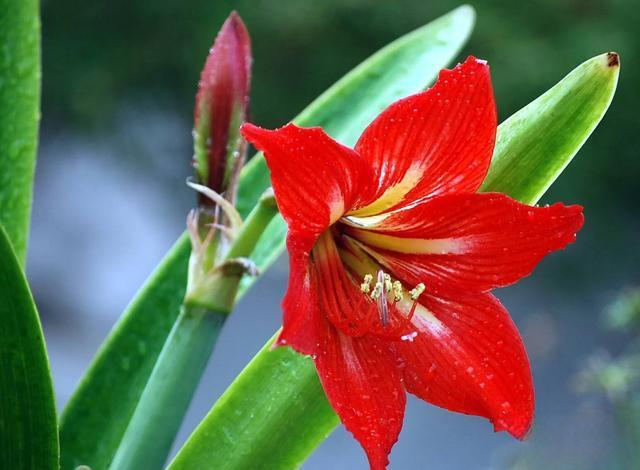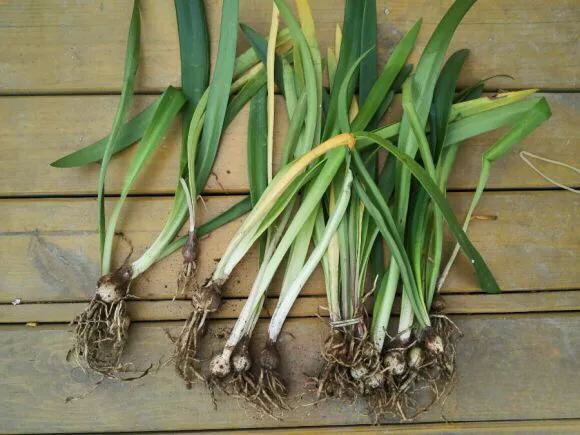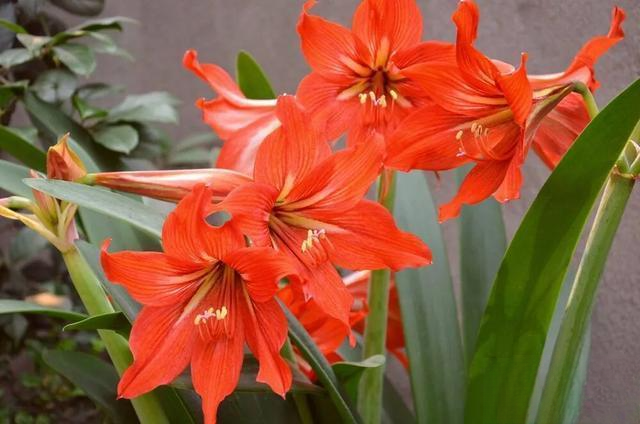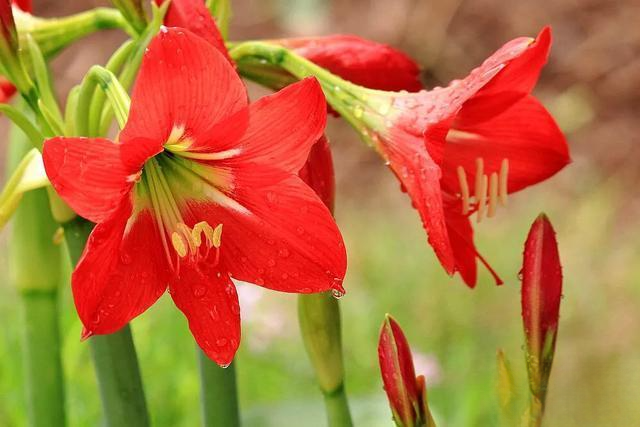Bareroot Amaryllis is difficult to survive? Pay attention to 3 stages, rapid adaptation and vigorous growth
Introduction: Amaryllis, also known as the pair of red, is a perennial herbaceous plant of the genus Amaryllis in the Amaryllis family. It has a beautiful plant shape, opposite leaves, broad, emerald green and shiny, and bright and eye-catching flowers shaped like small trumpets. When the flowers bloom, they give people a sense of auspiciousness and festivity, and are deeply loved by flower lovers. Amaryllis not only has a high ornamental value, but also implies "prosperity and wealth". It is a common potted ornamental flower.
A few days ago, Xiaoqi wrote an article about the difficulty of surviving the purchased jasmine. Recently, I received many private messages from flower friends. Among them, some flower friends said that the bare-rooted amaryllis they bought online did not survive after planting. They felt that they were a failure. The flowers they loved did not survive after planting. This is indeed a very annoying thing. Friends who often buy flowers should know that whether it is online shopping or going to the flower market, the amaryllis we buy are mostly bare-rooted, that is, the amaryllis seedlings are completely out of the soil. Although amaryllis has strong vitality and environmental adaptability, if the bare-rooted amaryllis purchased is not handled properly, coupled with improper maintenance after planting, it is easy to appear slow to adapt to the pot or unable to survive. So after buying the bare-rooted amaryllis, what should we do to make it adapt to the pot as soon as possible? Today, Xiaoqi will share with you some tips to promote the survival of bare-root amaryllis, hoping to help everyone.

1. Treatment of bare-root amaryllis after purchase
The treatment of bare-root Amaryllis after purchase is extremely important, which is related to the survival of the plant after planting. Improper treatment before planting is also a reason why Amaryllis is difficult to survive. The treatment of bare-root Amaryllis after purchase can be divided into the following four steps:
1. Slow down the seedlings
The amaryllis seedlings we buy are generally cultivated in greenhouses. The merchants will adjust the maintenance environment to the most suitable state for the growth of amaryllis, but our home environment is very different from it. When amaryllis comes to a new environment, both the temperature and humidity will be uncomfortable, so the slow growth of seedlings before planting is particularly important. We can place the bare-root amaryllis in a diffused light and ventilated place for 1-2 days to allow the plant to gradually adapt to the new environment, and then plant it in pots, which is more conducive to the adaptation of amaryllis. Some flower lovers may have questions, such as whether amaryllis will wilt due to lack of water during the slow growth period. In fact, there is no need to worry about this. Amaryllis has a spherical bulb that can store a certain amount of water. Even if it leaves the soil for a week, it will not be too short of water.
2. Pruning
Before planting bare-root amaryllis in pots, the plant needs to be pruned and all the messy, dead fibrous roots and rotten and deteriorated tissues need to be removed. Such roots are useless. If the rotten tissue is not dealt with, it may breed bacteria and infect other healthy roots.
In addition to treating the roots, the leaves should also be pruned, and all dry or rotten leaves should be cut off to prevent the leaves from breeding bacteria and causing the plant to be infected with pests and diseases. The leaves of Amaryllis may be damaged or broken during transportation. If there are no signs of infection, such leaves can be temporarily retained without treatment. Damaged and broken leaves can also perform photosynthesis, which can help the plant adapt to the pot.
3. Disinfection
Whether you buy bare-root amaryllis online or at a flower market, you need to thoroughly disinfect it after pruning. This not only prevents infection of the wound after pruning, but also removes various bacteria brought from the native environment. To disinfect amaryllis, you can use carbendazim or potassium permanganate solution diluted 1000 times with clean water to soak the whole plant. The soaking time is generally 20 minutes. Xiaoqi recommends using carbendazim for disinfection, because potassium permanganate is a strong oxidant, and the bactericidal effect can only last about 2 hours, while carbendazim is a broad-spectrum bactericidal agent with low toxicity and relatively long-lasting efficacy.
4. Dry
After the bare-root Amaryllis is soaked and disinfected, there will be a lot of water on the plant, especially in the heart of the leaf. The water is not easy to evaporate, which can easily cause the heart of the Amaryllis leaf to rot, especially when the temperature is high. Therefore, Amaryllis needs to be dried after soaking and disinfection to dry the water on the plant and the wounds caused by pruning to prevent infection of the wounds after planting. Place the Amaryllis plant in a cool and ventilated place to air dry (do not place it in the sun to dry). Generally, it takes a few hours or a day for the surface water to be completely evaporated. The higher the temperature, the shorter the time.

2. Planting of bare-root amaryllis after treatment
After the bare-root Amaryllis is purchased, it can be potted and planted after acclimatization, pruning, disinfection and drying. In order to promote the plant to adapt to the pot, the following points need to be noted:
1. Choose the right flower pot
When choosing a flowerpot for Amaryllis, you need to pay attention to two aspects: one is the size of the flowerpot, and the other is the air permeability and drainage performance of the flowerpot. The size of the flowerpot can be determined according to the size of the Amaryllis plant. Do not use a flowerpot that is too large. A flowerpot that is too large will hold more soil, and the dry-wet cycle of the soil will be slow. The soil is not easy to dry after watering, and a long-term wet pot soil is not conducive to the growth of the Amaryllis root system.
As for the material of the flower pot, we can choose a ceramic pot or a purple clay pot with good air permeability. If conditions do not permit, we can also use a plastic pot. However, in order to enhance the drainage performance of the flower pot, we need to poke a few more holes in the bottom of the pot. It is best to poke a few holes on the side of the flower pot, which is more conducive to the air permeability of the potting soil.
2. Prepare suitable soil
Amaryllis is a bulbous flower and has relatively high requirements for the air permeability and drainage performance of the planting soil. Loose, breathable and humus-rich soil is more conducive to the growth of Amaryllis roots and can also reduce the difficulty of later maintenance and management.
A single soil is difficult to meet the needs of Amaryllis. We can use a mixture of various soils as the cultivation medium, such as leaf mold, farmland soil, coarse river sand, and slag, which are prepared in a ratio of 4:2:1:1. The slag should be rinsed with clean water several times before use. It is more troublesome to prepare soil for Amaryllis. Of course, you can also buy special nutrient soil for Amaryllis on the market, but the cost will be higher.
3. Planting precautions
Many flower lovers are used to moistening the soil before planting Amaryllis, using the immersion method or spraying water on the soil, but Xiaoqi thinks it is unnecessary. No matter what substrate is used, bare-root Amaryllis needs to be watered thoroughly after planting, so that the roots of Amaryllis are closely combined with the soil without leaving any roots, which is also called fixed root water. As for the planting process of bare-root Amaryllis, there is nothing special, but there are still a few points to note:
① It is best to disinfect the prepared soil before use to prevent insect eggs, grass seeds or mold from lurking in the soil, which would increase the chance of the plants being infected by pests and diseases. The soil can be exposed to the sun for 2-3 days, or it can be fully scalded with boiling water and then dried.
② It is best to lay a layer of broken tiles or bricks at the bottom of the flowerpot, which can not only enhance the air permeability and drainage of the potting soil, but also prevent soil loss.
③The planting depth of bare-root amaryllis should be determined according to the length of the root system. It should be buried as shallowly as possible while ensuring that the root system is completely covered by soil to facilitate root breathing.
④ No matter what substrate you choose to plant bare-root Amaryllis, there is no need to add basal fertilizer. Even if basal fertilizer is added, it should be a small amount of fertilizer with a relatively low concentration, because the root system of the plant in the acclimatization period has a particularly weak ability to absorb nutrients. If the amount of basal fertilizer is not controlled well, it will increase the burden on the root system and even burn the root system, causing the death of Amaryllis.
⑤ After planting Amaryllis, do not compact the soil with your hands to avoid damaging the root system. If you want the roots to fit closely with the soil, just water it thoroughly once.

3. Maintenance of bare-root amaryllis after planting
The newly planted amaryllis is in the adaptation stage to the new pot soil. At this time, the root system of the plant is relatively weak and the functions of various organs are weakened. If it is not properly maintained, it is easy for the amaryllis to die. Therefore, in order to promote the amaryllis to adapt to the pot as soon as possible, the following points should be paid attention to:
1. Keep the temperature appropriate
Amaryllis likes a warm environment, and the suitable growth temperature is 18-25 degrees. Temperatures that are too high or too low are not conducive to the plant adapting to the pot. If the temperature difference is large after planting Amaryllis, then when the temperature drops significantly, the plant should be moved to a warm place for maintenance in time to prevent Amaryllis from being affected by the low temperature and having difficulty adapting to the pot.
2. Change the lighting in time
The newly planted amaryllis is relatively weak. If it is directly exposed to the sun, the water in the branches and leaves will evaporate too quickly, and the root system will not be able to absorb and transport enough water, making it difficult to maintain the physiological activities of the plant. The plant may wilt or even be killed by the sun. Therefore, the amaryllis must be kept away from direct sunlight after planting. It should be temporarily placed in a diffuse light place for 3-5 days, and then transitioned to soft light. When the light is too strong, shade the amaryllis, use a black net to block the sunlight, or move the plant to a cool place indoors for maintenance to prevent the amaryllis from being killed by the sun.
3. Proper control of water and fertilizer
Amaryllis likes moisture and is afraid of waterlogging. The roots of newly planted Amaryllis have a relatively weak ability to absorb water. If watering is too frequent at this time, the soil will remain moist for a long time, and the oxygen content in the soil will continue to decrease. Then the roots will have difficulty breathing due to lack of oxygen, causing the bulbs to rot. Therefore, Amaryllis in the acclimatization period should control water appropriately to keep the soil moist but not wet. After watering the potting soil, good ventilation should be maintained. During this period, water can be sprayed around the plant frequently to increase the air humidity. In addition, there is no need for topdressing in the short term. Topdressing can be done about two months after planting Amaryllis.

Summary: Bare-root amaryllis planting requires good pre-planting treatment, post-planting maintenance, and the correct planting method, so that the plant can adapt to the pot. There are many details that need to be paid attention to, such as root pruning, disinfection, and the selection of potting soil, etc. These are the basic conditions to ensure that amaryllis adapts quickly to the pot. Doing these well can increase the survival rate of amaryllis.
The above are Xiaoqi's personal experience and opinions. Please criticize and correct me if there are any shortcomings. If you like my article, please like and follow it. Thank you!